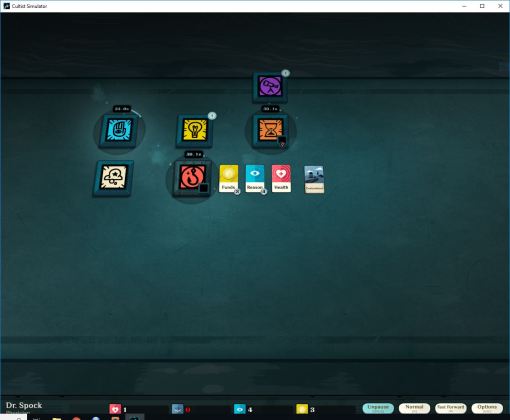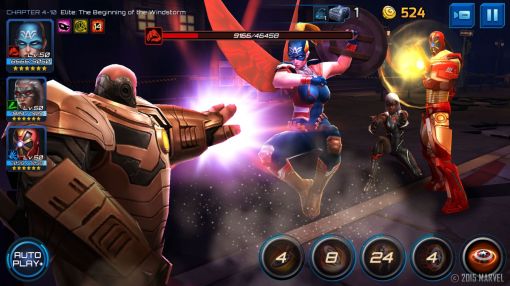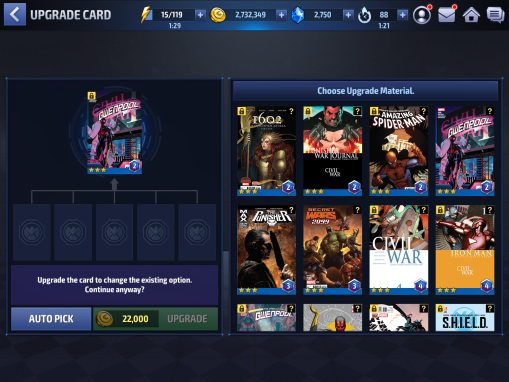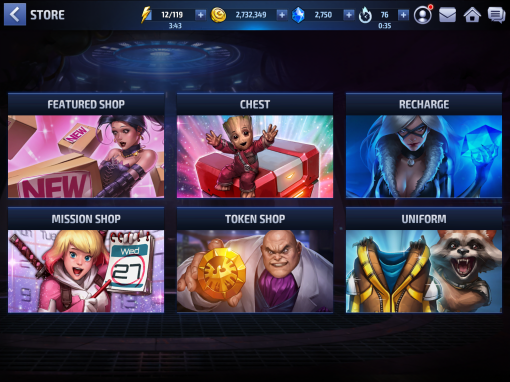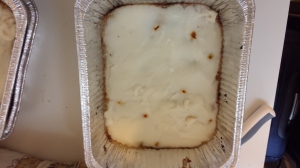So it’s been a few years since I posted about games, (or even in general). I certainly haven’t stopped playing them. My time has been more proscribed than in some times in the past. Consequently, I have played a lot of games that I can “fit in” during or between other activities. Hearthstone is definitely one of those. I can play it while I cook. I can play it while I walk to and from work.
So, how is Hearthstone these days? Well, right off the bat let me acknowledge that Hearthstone will never be as good or satisfying a game as some other CCGs that I play or have played. This is for the simple reason that there is no interaction with your opponent on their turn. Strategy can never be as deep, nor tactics as varied, as in a game like Magic: The Gathering (MtG) or Vampire: the Eternal Struggle (VtES). But until technology advances just a little more, every digital implementation I’ve seen that tries for Magic’s level of interaction ends up feeling a little clunky. So for now, Hearthstone is the best we’ve got without awkward interfaces (which can be as frustrating or more so than awkward game design).
So, Hearthstone is the best (that I’ve played in recent years). How good is the best these days? Well… not very. The past three expansions each have had a more stagnant and toxic metagame than the one before. Why? There are several reasons. Some quite simple. Some rather more complicated. Some have been talked about extensively by streamers. Others have either been mentioned in passing, or dismissed as trivial. So what are all these problems? Let’s enumerate them, then drill down for more detail:
- The Jade mechanic, particularly as implemented in Druid is oppressive.
- Aggro decks are getting faster and faster, often killing their prey by turn 5 or 6.
- Control decks that can actually survive those aggro decks are getting more brutal. If they survive past turn 6 or 7… they win.
- Gadgetzan Auctioneer continues to spawn aberrant decks that dominate the metagame. This is currently related to jade druid… but this has been going on for a long long time, so it gets its own bullet.
- The number of cards that are potentially game winning have increased dramatically. And not in a good way…
- The deck prospects for a F2P or low money player are worse than ever before. There is not a single top tier deck that would qualify as “low budget” these days.
Jade
Let’s start with the first point I listed: Jade Druid. I listed it first, because it’s probably the most noticeable. First a tiny bit of background. Two expansions ago, Blizzard released the Mean Streets of Gadgetzan. There were three “gangs” in the expansion, represented by a bunch of class specific cards, as well as something new: cards that could be used by three different classes. Each gang had a different mechanic as its theme. There was the “I only have 1 of each card in my deck, but I get special abilities because of it” gang. There was the “I buff cards while they’re still in my hand” gang. And then there was the Jade golem gang, which summoned jade golems of incrementally increasing power; the first was a 1/1, the 2nd a 2/2, and so on ad infinitum. It became quickly apparent that the themes were not at all equal in power. The Hand buff was terrible in warrior and hunter, and decent in paladin. The one of a kind gang was good when it first came out, but the next expansion, one of the two most powerful “one of a kind” triggered cards rotated out of the format! So the decks became far less reliable.
Jade was simple, and brutal. The least strong jade class, rogue, was still “okay”. Shaman was quite powerful, though usually with Jade as a auxiliary package to boost the power of an aggro strategy. Druid… was a juggernaut. The jade cards for druid included a 1 cost spell, Jade Idol, that either makes a golem, or shuffles 3 copies of itself into the deck! So with a little optimization, Jade Druid ended up as a deck that is almost as fast as many aggro decks, due to Innervate + mana ramp effects. In the control match, Jade druid crushes, because they just have to mana ramp and draw cards till they have a Gadgetzan Auctioneer, then cycle 4 or 5 jade cards in a single turn. Then, even if the control deck clears the board, the unlimited supply of Jade Idols (plus the 2nd Auctioneer) can quickly run over any defenses. The only way to beat Jade Druid, is to do it quickly.
Aggro
This brings us to our next point: while Jade druid has almost a 60% win rate (this is pretty crazy, considering that includes everybody, skilled or not)… the aggro decks that have evolved as the only hope to beat it are also crushing. Aggro shaman, aggro druid, pirate warrior. All of these decks output a crazy amount of damage. Aggro shaman and aggro druid can easily kill you on turn 5, unless you wipe their board completely… and then that buys you ONE extra turn while they re-flood the board. Aggro warrior is a (tiny) bit slower… but has the advantage that it’s damage is split between its minions and it’s weapons. If they clear your board, your weapon still clocks them in the dome. If they play a creature that destroys your weapon, your minions swarm them.
Why is this a problem? It heavily limits the sort of decks that can be played. By extension it is stifling creativity. If you have a cool idea for a deck, but it’s mid range or heavier, scrap it. You won’t get to play half the time. Why is that? In the past, mid range decks were the answer to aggro in Hearthstone. They had enough tempo tools to deal with aggro, while being a little weaker against control since they diluted their late game. That’s not the case anymore. If you spend your turn doing something mid range like killing one of an aggro druid’s creatures while developing one of your own, their turn will look like: develop another weenie or two, buff, buff, kill your creature and go face for 1/3 of your life. So, to survive you either have to go full control with tons of taunts/board wipes/heals. Or you have to join aggro, and put in the pirate+ Patches package AND early game removal AND some random weenies. At which point you end up being a crappier aggro deck that sometimes draws all their late game cards early and loses.
My reason for pointing this out, even though Druid is so dominant, is to understand that even if Jade disappeared tomorrow, the metagame has far more deep seated problems. Which brings us to:
Control
What sorts of decks can survive against the sheer weight of damage that I described above? Control decks. But not just any control decks. Control Hunter still isn’t a thing, no matter how much Blizzard tries to make it so. Control rogue is something I’ve tried to make work for a while; my most successful uses a hybrid of C’Thun and N’zoth tactics, which is janky as hell… and it mainly works against other control decks.
The successful control decks are the ones with a ton of board clears, combined with strong single target removal for priority targets. Let’s call this Heavy(tm) Control. The main classes that have had this consistently are Priest, Warrior, Shaman, and Mage. We’ll just look at one to see the problems these control decks can cause, when they’re too strong. Control priest is at the top of the heap. The removal in priest has always been insane. Between Shadow Word: Pain and Shadow Word: Death, they have 4 cards that answer anything but 4 power creatures. The base priest class has access to holy nova, which is so so, at 5 mana for 2 damage to everything, and Auchenai Soul Priest + Circle of healing, which is amazing at 4 mana for 4 damage to everything! The amazing thing is that priest has gotten so much better board clears that Auchenai+ circle doesn’t see much play. For years they had Lightbomb, and when that rotated out, they were given Dragonfire potion.
“Alright, so Heavy(tm) Control has the tools to maybe deal with the ravening hordes of aggro you mentioned before. What’s the problem?” Well, I’m glad you asked! Well, when you can reliably and efficiently remove (for some value, X of reliable, this is after all a random card game) every minion that your opponent plays within a turn or two of them playing them, you create a problem. The problem is that minions are what do most of the work in Hearthstone. So if you’re opponent can’t have any minions he doesn’t get to play the game. This isn’t fun, and it stifles creativity. Consequently, the thing that really seems to determine if heavy control is stifling the metagame is how much it gets played. This in turn is determined by whether the Heavy Control classes have dangerous and efficient payloads to back up their oppressive board control. If they do, the decks are dangerous and oppressive to the metagame. If they don’t, the decks are pointless and annoying, but don’t ultimately win a lot, and die away till the next sea change.
So here we have come to the crux of the problems: The classes all have core cards that never go away… and those core cards create some bad dynamics. Let us return to the example of Priest. Within priest’s core cards, the makings of a strong, bordering on oppressive removal package. They have two of the most efficient single target removal spells in the game: the cheapest (tied with Paladin) board clear combo and decent aoe otherwise. In expansions where they have good late game threats, they are strong. In expansions where they get better board clear they become stifling. In expansions where they have both they become stifling and strong, which means they affect the metagame and start killing creativity and fun. Blizzard should be aiming for Strong, but not stifling. Instead, they consistently “print” cards for these classes that are more controlling. And in a sense, this is necessary because of the Aggro problem I mentioned before… but in a more real sense that’s like bringing in foxes to deal with your rabbit problem. They may eat the rabbits if they can catch them… but they’re going to eat a whole lot more of your chickens.
This sort of brings this arc of the discussion to a close. Now I’ll start talking about the power of specific cards.
Gadgetzan Auctioneer
Holy crap. They nerfed the cost of the card a number of years ago… but it’s effect is so powerful that it didn’t matter. The card is only really powerful in Rogue and Druid due to their free or cheap spells… but it is so powerful, it is game warping. Some version of Miracle Rogue has been in and out of the competitive spotlight since the beginning. In some periods (notably the current one), Druid uses is as well. Even before the current focus of people’s rage came out, Ultimate Infestation, Jade druid was dominating the metagame with Auctioneer.
It is predictable. Card draw in Hearthstone, much as in MtG, is a precious resource. So, a single card that lets you draw 4 or 5 cards in a single turn is enormously powerful. That Auctioneer is also a 4/4 creature and so demands non-trivial effort to remove it to prevent it drawing another 4-5 cards the next turn… well, the results speak for themselves. Any time playing a bunch of cheap spells and redrawing can give you a big advantage, Auctioneer comes back. The fact that it only features in the decks it does is a testament to Blizzards restraint at printing low cost spammable spells. But that restraint is a product of the limits that Auctioneer has placed on the design space. When, as in the case of Jade Idol, Blizzard steps over the line, the results are immediately visible.
Auctioneer should have been retired to the Hall of Fame. It still can be. It boggles my mind that they retired Conceal, worried about combos with it… but left Auctioneer, that combos with everything… including Conceal. It would be one of the steps necessary to help bring the game system to a place where cards can be developed and new decks played without feeling like you’re wasting your time. Because that amount of card draw is too strong.
And I think that’s enough space donated to one card, so let’s talk about:
All the other overpowered cards
I was watching a video by Reynad ( a Hearthstone streamer) recently, and a thing he said struck a chord with me. “Games where Innervate is drawn feel so different from games where Innervate is not drawn.”
Innervate is really obvious. It stands out because you find yourself facing a Turn 1 Vicious Fledgling, or a Turn 2 Bittertide Hydra. But Innervate is not unique. Over the past few expansions, the number of cards that have been printed that heavily swing the chances of winning, has increased drastically.
Hearthstone is nice, in that there are a bunch of places that collect data on hundreds of thousands of games played, and whether certain cards got played. HS Replay is one. Let’s take Patches the Pirate as an example. The stats show that if you have Patches in your deck, and you don’t play him (i.e. you pull him directly onto the field using his special ability) your chance to Win the game increases by 12%! That’s huge. Playing (or in this case, triggering using one of several other pirates in your deck) a single card gives that big a jump in power.
But patches isn’t unique. A lot of what gives ALL the dominant decks their power are a bunch of super cards. For instance, even if you clear aggro druids first big board, They can refill their board instantly using Living Mana. And then they can do it again if you re-clear. Murloc paladin can increase it’s murloc synergy heavily if they play Vilefin Inquisitor, changing their hero power to generate Murlocs, so when they play their Murloc Warleader and Gentle Megasaur, the number of buffed murlocs is higher. And they can finish off their opponents or clear their big minions with a well placed Sun Keepr Tarim. Similarly, after surviving the early game using spells they generated with Shadow Visions, clearing the mid game board with their Dragonfire potion, the priest can transition to their late game direct damage strategy playing Shadowreaper Anduin, which also clears all the big creatures at the same time.
I could go down the Top tier decks one by one, but the picture is the same; they are all loaded down with cards that, if you were to leave them out, would dramatically decrease the win rate of the deck. And oddly enough, almost all of those cards are Epics or Legendaries. More crucially, the power cards in decks are now Epics and Legendaries that are either class specific or, in the case of the Murloc synergies, only playable in a murloc deck.
So really my last point is two-folded:
- There are far too many cards that are being put out where if you draw them, you are at a heavy advantage (Shadowreaper Anduin increases your chance of winning from 52.1 to 62.5%, which is a increase of 20% of your wins). This means the games feel more random. It’s not a nice feeling to have your opponent play Raza the Unchained on Turn 5, and Anduin on Turn 8, when priest has no card draw. For anyone with a statistics background, you know it’s not that likely to draw both (there’s only one each since they’re legendary) in your first 11 cards, especially since they’re expensive enough that you probably won’t keep them in a mulligan.
- The power cards that are swinging the game so much are, as I mentioned, expensive. In my last post about Hearthstone, I believe I took heart in the fact that, while not terrible interesting, a F2P player could put together one of the top tier deck relatively cheaply. That is no longer the case. The control decks are made of masses of Rares, epics and Legendaries. Even the aggro decks are quite expensive. Take aggro druid, which might be the cheapest: It has Patches the pirate, 2 Living Mana and 2 Bittertide Hydras. That’s 1 legendary and 4 Epics. Almost every other deck has far more. Also as I mentioned, with the exception of Patches, most of the power cards are deck specific. I’m honestly not sure why they went out of their way to remove Sylvanus and Ragnaros. They were seeing a lot of play because those were the only legendaries some people had crafted.
The Takeaway
Well, the ultimate message is that the Hearthstone metagame is a mess that kills creativity (if you like winning). There are a number of underlying causes, some as old as the game itself, others introduced in the past few expansions. In the time it’s taken me to write this post, blizzard announced a handful of nerfs. Innervate will now only produce one mana. I’m not sure how this will turn out. It will hurt aggro druid far more than Jade. Heck, jade might still keep it in the deck, it will just make their crazy jade auctioneer turn happen one turn later.
Regardless of the outcome of these cosmetic nerfs, I think the systemic imbalances are far more deep seated. The game will continue to be broken.
